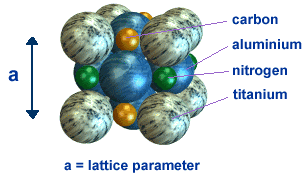PVD coating theory - What are PVD coatings?
|
|
Hard PVD ceramic coatings - What are they made of?
Hard materials suitable for thin films are predominantly but not entirely carbides, nitrides, borides and silicides of the IVth, Vth and VIth groups of the periodic table. Such materials are formed by introducing nitrogen, hydrocarbon, or silicide during the sputtering process. It is thought that the compound is formed at the surface of the substrate. An example being titanium aluminium carbo-nitride, TiAlCN.

Artists's impression of the structure of TiAlCN
|
Hard PVD ceramic coatings deposted using vacuum coating techniques such as sputtering or arc evaporation are used in many applications because of their outstanding wear resistant properties. They have continually developed but can be divided into four distinct generations.
Hard PVD ceramic coatings - Single metal nitride PVD coatings e.g. TiN, CrN, ZrN
The first generation of hard PVD coatings were single metal nitrides such as TiN, CrN and ZrN. They have been exploited commercially since the middle of the 80’s in cutting applications because of their higher hardness compared to high speed steel and cemented carbide and for decorative purposes because of their attractive appearance. TiN has a distinctive yellow-gold colour, CrN looks unsurprisingly like chrome and ZrN has a green-gold colour. ZrCN is used to simulate gold in decorative applications such as watch cases.
These PVD coatings are still available and in many applications are the best option. However their temperature resistance is insufficient for applications such as high speed machining. TiN for example decomposes at 450 °C. Therefore the next step in the development of hard PVD coatings was the improvement of the temperature resistance to make the coatings more suitable for applications such as high speed machining and and general high temperature wear protection.
Hard PVD ceramic coatings - Alloyed elements improve oxidation resistance, e.g. TiAlN
This improvement in temperature resistance was achieved by introducing other elements such as Cr, Al or Y, into the TiN lattice.
Hard PVD ceramic coatings - The development of superlattices
Further improvement to the properties of hard PVD coatings was achieved in the third generation of hard PVD coating development through the deposition of multilayers and superlattices. These are thin films formed by alternately depositing two different components to form layered structures. Multilayers become superlatices when the period of the different layers is less than 100Å.
Multilayered coatings of materials with similar crystal
structures tend to form columnar crystals which extend
through the whole coating, provided that the thickness of the
individual lamellae is sufficiently thin, typically 5–25 nm.
Such coatings are referred to as superlattice coatings. One
of the first examples of superlattice coatings was obtained
by combining TiN/VN and TiN/NbN. Several authors
have shown that this type of multilayered coating
structure can improve the hardness as well as the toughness,
compared to single layers of the same materials.
Superlattice strengthening is
well known from classical metallurgy.
By selecting a suitable combination of materials for the
multilayered structure it is possible to improve the resistance
against wear, corrosion, oxidation, etc.
Hard PVD ceramic coatings - The recent development of nanocomposite coatings
A nanocomposite coating consists of at least two phases: a nanocrystalline phase and an amorphous phase, or two nanocrystalline phases. The basic idea for the design of nanocomposites is based on the thermodynamically driven segregation in binary (ternary, quaternary) systems. The segregation leads to the spontaneous self-organization of a stable nanoscale structure. This generic concept has recently led to the development of nanocomposite PVD coatings. These PVD coatings have nanometer sized grains and exhibit enhanced yield strength, hardness and toughness properties as a result of the well-known Hall-Petch effect . The only PVD nanocomposite coating currently commercially available is supplied by Unimerco, Platit and SHM.
Low friction coatings
Attention recently has focussed on the development of hard, wear resistant, low friction coatings such as Graphit-iC™, MoST™ and Dymon-iC™, with the automotive industry again the driving force. If you follow the purple links or use the menu options at the head and foot of the page you will find a more in-depth discussion about these and all the other leading PVD coatings mentioned.

|